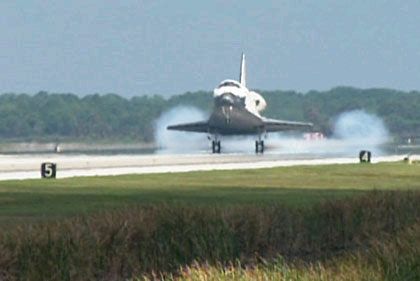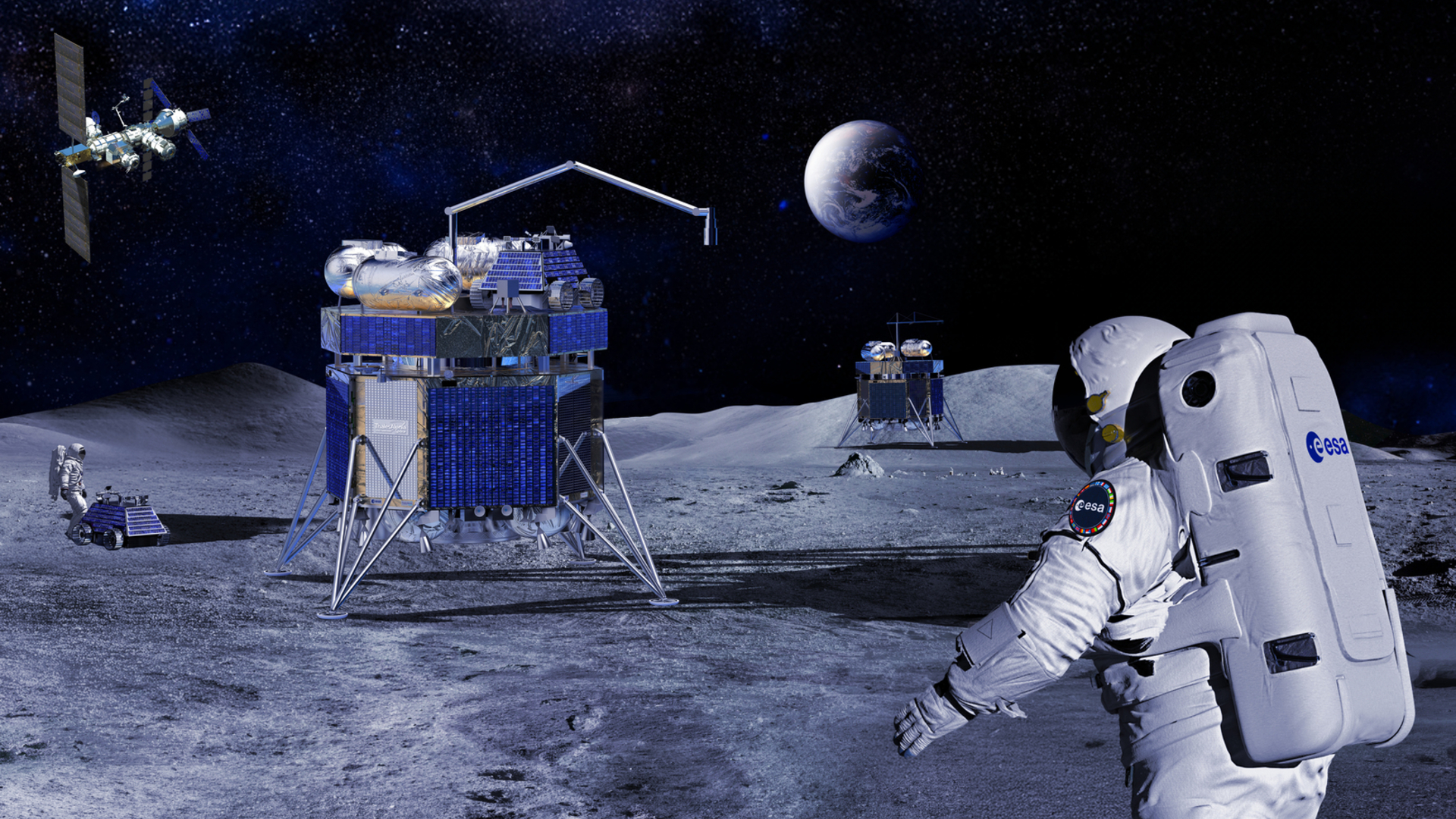Space Shuttle Discovery Lands Safely

Thisstory was updated at 2:23 p.m. EDT.
CAPECANAVERAL, Fla. — The space shuttle Discovery landed safely back on EarthSaturday to wrap up a two-week mission that delivered a new Japanese laboratoryto the International Space Station (ISS).
The shuttletouched down on a NASA runway here at the Kennedy Space Center at 11:15a.m. EDT (1515 GMT), loosing twin sonic booms as it swooped down out of themidday Florida sky with commanderMark Kelly at the helm.
“Beautifullanding, Mark,” astronaut Terry Virts radioed the crew from MissionControl in Houston. “Congratulations on a great mission.”
“It’sgreat to be back,” Kelly replied. “And it’s great for all ofus to be part of a team that made the space station a little bit bigger and alittle bit more capable.”
Kelly andhis six-man, one-woman crew delivered a new crewmember, spare Russian spacetoilet parts and the massive $1billion Kiboresearch module for the Japan Aerospace Exploration Agency (JAXA) whiledocked at the orbiting laboratory.
Theastronauts launched May 31 and completed 217 trips around Earth during their5.7 million-mile (9.1 million-km) construction flight.
Breaking space news, the latest updates on rocket launches, skywatching events and more!
Returningto Earth with Kelly were shuttle pilot Kenneth Ham, mission specialists KarenNyberg, Ronald Garan,Michael Fossum,Japanese astronaut Akihiko Hoshideand returning space station crewmember Garrett Reisman.
Togetherthey performed three spacewalks to maintain the station, test out ways to cleana damaged solar array gear and outfit the new Kibo lab. They also attached Kibo’s rooftopstorage module, which a previous crew delivered in to a temporary berth last March.
“Ithink is just a start, just a beginning,” said Hoshide before landing. “We learneda lot from this mission, so we’ll just continue to learn more.”
Spacestation’s new “Hope”
Weighing inat some 32,000 pounds (14,514 kg), Japan’sKibo(which means “hope” in Japanese) is 37 feet (11 meters) long, aboutthe size of a large tour bus and the largest room ever launched to the spacestation. It has two small windows, a 33-foot (10-meter) main robotic arm and asmall airlock for passing experiments out to a porch-like external platformslated to launch next year.
Nyberg saidthe views out the Kibolab’s side-looking windows were tremendous and offered a new perspectiveof Earth from the space station.
“It’sa great view looking in a direction that we can’t see in other parts ofthe U.S. segment,” she said. “Watching the sunset was my absolutefavorite, and I think we got a lot of pictures of that.”
With Kibo’sinstallation, the space station is about71 percent complete, weighs about 612,000 pounds (277,598 kg) and has aliving area about the size of the interior of a 747 jumbo jet, according toNASA and station crew. When complete, the station is slated to have about asmuch room as a five bedroom home and rival a U.S. football field in length,NASA has said.
For Reisman,Discovery’s landing marked his first taste of Earth’s gravity after95 days living in space, and he returned to Earth in a special reclined seat toease the burden. He arrived at the space station in March and was replaced lastweek by NASA astronaut Gregory Chamitoff, who launched aboard Discovery.
“I amcautiously optimistic,” he said of how his body will respond to itsreturn to gravity, adding that there is some anecdotal evidence than his shortstature may help since his sensory organs are closer to his center of gravity.“I’ve been waiting my whole life and I finally think being short isgoing to come in handy.”
It apparentlydid. After landing, Reisman was all smiles in NASA video as he walked on thetarmac with his crewmates to inspect Discovery and pose for photos.
“Hetold us, frankly, that he enjoyed feeling the sunshine again,” saidWilliam Gerstenmaier, NASA’s chief of space operations. “I think hehad a great time onboard space station.”
Reismanhas said he’s looking forward to seeing his wife Simone and cat Fuzzyagain, and digging into a juicy steak after landing.
Chamitoff,meanwhile, is beginning a six-month mission and watched a live broadcast ofDiscovery’s landing from orbit.
“Whata beautiful landing!” Chamitofftold Mission Control. “It was a spectacular mission from end toend…we have this new ‘hope’ in the Kibo module here on the space stationand it’s a great success.”
Successfulflight
Today’slanding marked the end of NASA’s 123rd space shuttle mission and the 26thconstruction flight to the space station. Discovery made its 35th trip to spaceduring the mission, the third shuttle flight this year to deliver a new orbitalroom to the high-flying station.
“Weare very pleased with the mission’s accomplishments,” saidNASA’s deputy shuttle program manager LeRoy Cain. “We’re veryproud of the whole team.”
NASA plansto fly 10 more shuttle flights to complete the space station and overhaul theHubble Space Telescope before retiring its aging three-orbiter fleet in 2010.The Hubble mission - the final servicing flight to the orbital observatory - iscurrently slated to liftoff on Oct. 8 pendingthe repair of its Pad 39A launch site here, which was damaged duringDiscovery’s launch.
Thesuccessful STS-124 spaceflight marked NASA’s third of up to five shuttleflights this year, with the Hubble serving mission and a fourth flight to thespace station remaining. It was the 10th mission since the 2003Columbia tragedy.
“Thewhole experience turned out to be more emotional than I’d expect,”said shuttle pilot Ken Ham. “Seeing space station out the window andrealizing that it’s all very real and we’re part of it, it’sa great time to be part of this country. It’s a pretty incrediblefeeling.”
NASA isbroadcasting the Discovery's STS-124 mission live on NASA TV. Click here for SPACE.com'sshuttle mission updates and NASA TV feed.
- New Video: Shuttle Discovery's Space Station Victory Lap
- New Video: Shuttle Booster's Wild Ride
- Video: Grand Opening for Station's Kibo Lab

Tariq is the award-winning Editor-in-Chief of Space.com and joined the team in 2001. He covers human spaceflight, as well as skywatching and entertainment. He became Space.com's Editor-in-Chief in 2019. Before joining Space.com, Tariq was a staff reporter for The Los Angeles Times covering education and city beats in La Habra, Fullerton and Huntington Beach. He's a recipient of the 2022 Harry Kolcum Award for excellence in space reporting and the 2025 Space Pioneer Award from the National Space Society. He is an Eagle Scout and Space Camp alum with journalism degrees from the USC and NYU. You can find Tariq at Space.com and as the co-host to the This Week In Space podcast on the TWiT network. To see his latest project, you can follow Tariq on Twitter @tariqjmalik.
